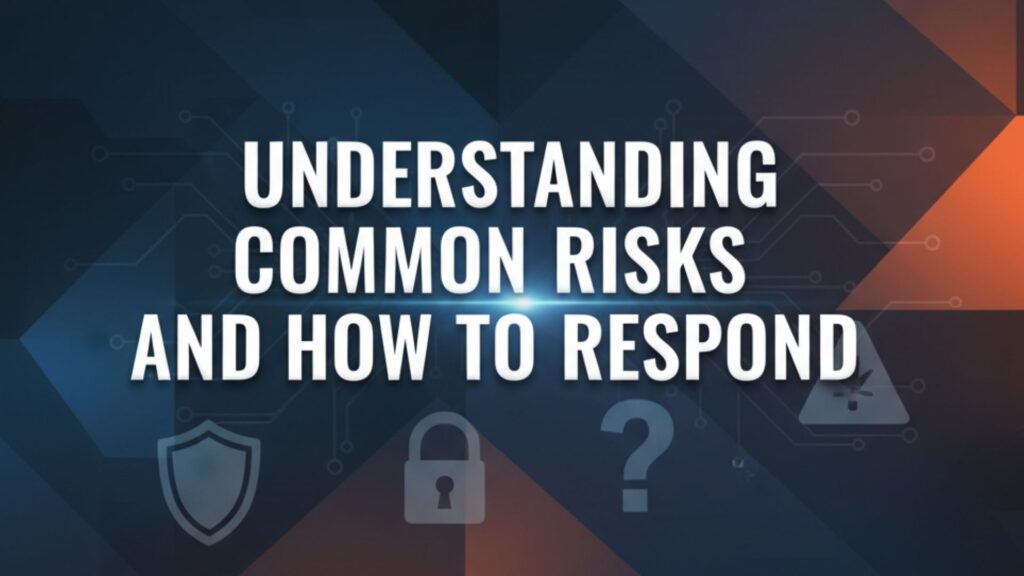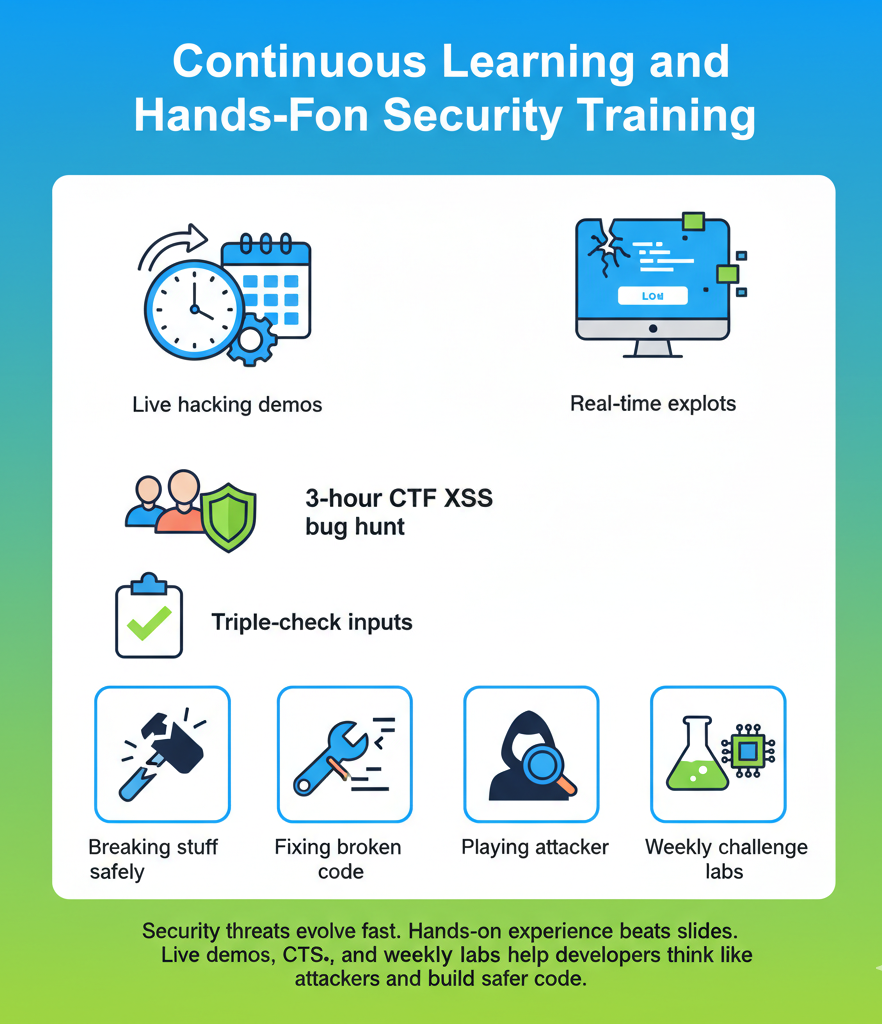
A developer’s security mindset goes beyond running a scanner or reading a list of do’s and don’ts. We see it in our classes – when students start thinking about what could go wrong, not just what should work right. Smart coders check every input like they’re guarding their own bank account.
They lock down permissions tight, and test for weak spots early (before the bad guys find them). Our most successful graduates stay paranoid about SQL injection and cross-site attacks, knowing these basics stop most breaches. Want to build security into your code from day one? There’s more to learn.
Key Takeaways
- Think like a hacker – expect attacks and plan defenses early.
- Build security checks into code from day one.
- Stay current and keep your team’s security skills sharp.
The Security Mindset: More Than Just Awareness
Our dev bootcamp students often come in thinking security’s just about running scans and following rules. Wrong. Dead wrong. After teaching hundreds of developers, we’ve learned the importance of security mindset coding goes far beyond running scans, it’s about rewiring how coders think about every line they write. Every line of code needs a “what if someone tried to break this?” mindset behind it.
Smart developers (the ones who usually ace our advanced courses) don’t wait for trouble – they expect it. They check inputs like they’re guarding Fort Knox, limit access permissions to the bare minimum, and test their code against common attacks. When our alumni take this approach back to their jobs, their teams spot problems way before deployment.
- Watch every input like a hawk
- Lock down permissions tight
- Test early, test often
- Keep learning new attack patterns
Real security isn’t a checkbox – it’s a survival skill. Most of our graduates say this mindset shift changed how they code forever. Looking to level up your security game? Keep reading.
Understanding Common Risks and How to Respond

It’s almost funny – SQL injection attacks still work in 2024. Our students are shocked when they learn how many sites still fall for these basic tricks. After teaching secure coding for five years, we’ve seen every flavor of database hack imaginable. Here’s the thing: most attacks work because someone didn’t check their inputs or trusted data they shouldn’t have.
Take APIs – they’re like leaving your front door open if you’re not careful. One grad told us how their company leaked customer data through error messages (rookie mistake). These days, we teach students to lock everything down tight and never trust user input. Period.
Common risks that bite developers:
- SQL tricks that bypass login screens
- Cross-site attacks that steal cookies
- Exposed APIs without proper checks
- Sessions that never timeout
Embedding Security Early in the SDLC
Waiting to think about security until after coding? That’s like installing locks after a break-in. Smart teams (and our best students) start security planning on day one. They sketch out attack scenarios before writing a single line of code.
Static code checks catch the obvious stuff – we run these hourly in our advanced classes. But the real magic happens when developers start testing their running apps against real attacks. One team caught 23 bugs in a single afternoon using these tools together.
What works best:
- Finding bugs while coding’s still fresh
- Fixing security holes before they ship
- Teaching developers to spot trouble early
The money saved? Massive. The headaches avoided? Even bigger.
Continuous Learning and Hands-On Security Training

Security threats change faster than the weather in New England. Last month’s patch becomes next week’s exploit. That’s why our bootcamp runs live hacking demos and security mindset training programs that throw developers into real-world attack scenarios instead of just PowerPoint slides. We’ve seen students’ eyes go wide when they first crack a vulnerable login page (in our test lab, of course).
Throwing developers into CTF challenges works better than any slideshow. One team spent three hours hunting down a sneaky XSS bug, and now they triple-check every input field. You can’t beat hands-on experience.[1]
What actually sticks:
- Breaking stuff (safely) to learn how to protect it
- Fixing intentionally broken code
- Playing attacker to think like one
- Weekly challenge labs that mimic real attacks
Cultivating a Security-First Team Culture
Someone once told us security’s everyone’s job, but nobody’s responsibility. Wrong approach. The best dev teams we’ve trained share security tips like developers usually share Stack Overflow links, proving that cultivating a security mindset is what makes security stick across an entire team. When a junior dev spots a security hole, they speak up – no questions asked.
Our most successful graduates became their teams’ security champions, not because we told them to, but because they couldn’t stop seeing risks everywhere. They check each other’s code for gotchas and swap war stories about close calls.
What makes it stick:
- Trading security tips becomes normal
- Code reviews catch weird stuff early
- Everyone owns security, not just the “security person”
The payoff? Teams that ship safer code without slowing down.
Practical Secure Coding Practices We Follow
Developers looking to strengthen their security mindset can start with concrete coding habits. Our team emphasizes:
- Input validation: Never trust user input; always sanitize and validate.
- Least privilege: Limit access rights to only what’s needed.
- Secure error handling: Avoid exposing sensitive information in error messages.
- Use of secure libraries and frameworks to reduce vulnerabilities.
- Encryption basics for data protection in transit and at rest.
These practices reduce the attack surface and make exploitation far more difficult. We pair them with automated testing tools and manual reviews for thorough coverage.
Tools That Help Us Stay Ahead
Static Application Security Testing (SAST) and Dynamic Application Security Testing (DAST) tools have become indispensable. SAST scans code for vulnerabilities early, catching issues like injection flaws or insecure API calls. DAST tests running applications to detect runtime vulnerabilities, such as broken authentication or session management problems.
We integrate these tools into our continuous integration pipelines, so security feedback is immediate. Combined with developer education and peer reviews, this layered approach ensures vulnerabilities are addressed quickly.
Key benefits include:
- Automated vulnerability detection reduces human error.
- Faster remediation through early alerts.
- Supports shift-left security integration.
Thinking Like an Attacker: The Red-Team Mindset

Breaking stuff teaches more than building it – that’s what our advanced security students learn first. Last month, a team found three hidden bugs just by asking “What if someone tried to trick the login?” Smart developers don’t wait for hackers to find holes – they hunt them down first.[2]
Most security flaws show up when you stop thinking like a coder and start thinking like someone trying to cause trouble. Our graduates learn to spot weak spots in authentication, find places where bad input could slip through, and catch data leaks before they happen.
Common weak spots we teach students to check:
- Login systems that trust user input
- APIs that leak too much info
- Unsanitized database queries
- Exposed admin functions
- Session tokens that never expire
Sustaining the Security Mindset Over Time
Credit: ITRAC
Security’s like muscle memory – use it or lose it. Fresh threats pop up daily, and yesterday’s patches might not cut it tomorrow. Our alumni who stick with security longest are the ones who never stop poking at their code, looking for weak spots.
One team lead (from our 2023 cohort) runs weekly “break this code” challenges. Another started a security book club – sounds nerdy, works great. The point isn’t perfection – it’s staying sharp enough to catch the obvious stuff before it bites you.
Ways to keep the security muscle strong:
- Weekly team security reviews
- Monthly capture-the-flag games
- Rotating security champion roles
- Threat modeling new features
- Building attack scenarios
Conclusion
Building a robust security mindset isn’t just about slapping on protections after the fact – it’s about making security part of a developer’s DNA from day one. Smart teams know breaches might happen, so they plan ahead. They train their people, test early and often, and make security checks as normal as morning coffee.
Getting there takes work, but the payoff’s worth it: code that’s safer and teams that sleep better at night. For real growth in security, there’s no better starting point. Join the Secure Coding Practices Bootcamp now, and turn security into your team’s second nature.
FAQ
How does a developer build a strong security mindset while working on secure coding and threat modeling?
Developers can build a real security mindset by learning to see code through the eyes of an attacker. Secure coding habits, paired with threat modeling, help spot weak spots early. Instead of waiting until the end, they can think about application security from the start, reducing software vulnerabilities. This doesn’t mean stacking on endless rules, it means staying mindful during design, writing, and testing. Over time, it becomes second nature, guiding choices that keep projects safer without slowing down the development flow.
Why is secure software development tied so closely to security best practices and a security-first culture?
Secure software development thrives when a team follows clear security best practices and works within a security-first culture. It’s not only about adding tools,it’s about how people think. By treating SDLC security as part of everyday work, developers focus on code security and reduce hidden risks. Shared security awareness and ongoing security training help everyone stay sharp. This turns scattered efforts into steady habits, where both senior engineers and new team members see safety as part of their craft, not just a checklist.
What role do security testing methods like static application security testing and dynamic application security testing play in risk management?
Security testing keeps risk management grounded in facts. Static application security testing with SAST tools scans code before it runs, while dynamic application security testing with DAST tools checks behavior in action. Both shine light on different types of software vulnerabilities. When combined with software composition analysis and regular vulnerability management, developers gain a clearer view of weak spots. These methods don’t just find flaws, they feed into prevention strategies that shrink the attack surface. Smarter testing makes applications sturdier against today’s shifting threat landscape.
How do secure design principles, cryptography, and least privilege help with attack surface reduction?
Secure design principles form the backbone of safe systems. Adding cryptography and strong authentication methods makes secure communication possible, while least privilege keeps access narrow. Together, these choices drive attack surface reduction, closing doors before attackers even knock. Developers also rely on input validation, output encoding, and steps like cross-site scripting prevention or SQL injection prevention to harden defenses. This approach isn’t about being paranoid,it’s about building with intention so that both everyday users and sensitive data remain protected in an unpredictable environment.
Why should developers focus on penetration testing, code reviews, and security automation within the secure development lifecycle?
Penetration testing and code reviews help expose problems that scanners miss. They also keep code quality and security aligned across teams. Security automation fits right into continuous integration security, creating a steady security feedback loop inside DevSecOps. These steps help enforce security policies, refine secure architecture, and test applications before they reach production. Adding security metrics and vulnerability scanning along the way keeps progress measurable. With this mix inside the secure development lifecycle, developers protect application integrity while adapting faster to new threats. It’s about working smarter, not harder.
How does incident response connect with logging and monitoring, application integrity, and secure APIs?
Incident response isn’t just about fixing after the fact,it’s about preparing ahead. Logging and monitoring give developers the clues they need when something feels off, while application integrity checks highlight tampering. Secure APIs and security patches add safeguards to keep software reliable. When combined with secure session management, user access control, and data protection, teams can respond faster and contain damage. These layers also support compliance requirements, ensuring rules are met while keeping systems steady. A strong response plan turns surprises into manageable setbacks instead of disasters.
References
- https://www.ncsc.nl/binaries/ncsc/documenten/rapporten/2022/september/15/effectiviteit-van-ctf-educatie/TLP_CLEAR_NCSC_Report_Effectiveness_of_CTF_education.pdf
- https://en.wikipedia.org/wiki/SQL_injection

